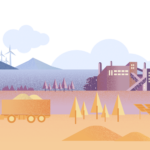We aim to achieve carbon-neutral electricity and heat generation by 2035.
In 2019, the proportion of EPV Energy’s production that came from
- renewable energy sources was 47.1 per cent
- emission-free energy sources was 82.4 per cent
EPV Energy generates and acquires electricity and heat for its shareholders, i.e. Finnish energy companies. EPV Energy has more than 65 years of experience in responsible energy generation. We focus on emission-free and reliable energy generation with determination and purpose. At EPV Energy, we have greatly improved our range of energy generation, resulting in significant reductions in carbon dioxide emissions.
In 2019, wind power accounted for 17.4 per cent of EPV’s energy generation
EPV Energy is a leader in emission-free energy generation, for example in utilising wind power and domestic forest energy. In line with the company’s strategy, we will also continue our purposeful work towards emission-free energy generation in the future.
EPV Energy is the leading actor in producing industry-scale wind power in Finland, having started its wind power programme as early as 2006. In 2019, approximately 17.4 per cent of EPV’s energy generation was already coming from wind power.
Wind power is one of the company’s most important energy generation methods. The goal in the business area of EPV Wind and new technology is to further increase the proportion of emission-free energy generation for the Group.
Decision to construct our fifth wind farm
In 2019, EPV Energy Group made the decision to invest in building 21 new wind turbines on Paskoonharju in Teuva.
The project is a market-based wind power investment that is being made without funding from public institutions. Construction on EPV Group’s fifth industry-scale wind farm is expected to conclude in 2022. Preparation work for the expansion of the wind farm has already begun. The construction of foundations will be completed in 2020, and wind turbines will be erected in 2021.
EPV’s wind power development has always had its basis in the long-term perspective, and having our projects driven by the market has been our goal from the earliest days. That goal has now been achieved. With the completion of the Teuva project, EPV Energy Group’s wind power companies’ annual output is set to exceed one terawatt-hour.
We produce emission-free base load power and balancing power for renewable forms of energy
Hydroelectric and nuclear power is produced in EPV Power’s business area by EPV’s affiliated companies Pohjolan Voima, Teollisuuden Voima and Voimapiha. Production takes place on an industrial scale, generating emission-free base load power and balancing power for renewable forms of energy.
When produced in a responsible way, nuclear power is an environmentally friendly and safe way of producing electricity throughout its lifespan. The lifespan of nuclear power plants is several decades, and they produce emission-free electricity in a similar manner to hydroelectric and wind power.
The Olkiluoto 3 nuclear power station unit received an operating licence
Teollisuuden Voima is an energy company that produces electricity at the Olkiluoto nuclear power station in Eurajoki with two plant units, Olkiluoto 1 and Olkiluoto 2.
In March 2019, the Finnish Government granted an operating licence to Teollisuuden Voima Oyj’s (TVO) OL3 nuclear power plant unit that is being completed in Olkiluoto, Eurajoki. The licence is valid until the end of 2038. According to the current schedule, Olkiluoto 3 will be connected to the national electricity grid in November 2020 and regular electricity production will begin in March 2021.
In 2019, nuclear power represented 28.5 per cent of EPV’s power procurement. Olkiluoto 3 will double EPV’s nuclear power production. In 2025, nuclear power is expected to make up approximately 40 per cent of EPV’s energy generation.
Producer of hydroelectric power actively maintains and develops water environments
Our affiliated company, Pohjolan Voima, produces hydroelectric power in Finland. The company actively maintains and develops water environments by
- restoring shorelines
- fish stocking and transporting
- cooperating in projects that aim to restore migratory fish stocks.
EPV Energy is also a part owner of Voimapiha Oy, which delivers renewable energy from Swedish hydroelectric power plants to its shareholders. Voimapiha is also indirectly involved in Sweden’s hydroelectric power fund, which began its activities in early 2019. The hydroelectric power fund’s shareholders are responsible for 95 per cent of Sweden’s hydroelectric power production. Hydroelectric power plants will be able to apply for funding in the future to meet modern environmental requirements. In 2019, hydroelectric power represented 20.3 per cent of EPV’s power procurement.
Cleaner district heating for the inhabitants of Tornio and Haparanda
The emissions created by the district heating and steam of Tornio and Haparanda cities and the Outokumpu company fell in 2019 because Tornion Voima, which produces heating for the area, stopped using heavy fuel oil. The use of fuel oil was terminated primarily for environmental reasons. The replacement fuel, natural gas, is not only significantly cleaner than heavy fuel oil, but cheaper as well.
The installation of Tornion Voima’s natural gas burners for reserve power boilers was successful, and, starting in early 2019, all the reserve power boilers can be used with natural gas and coal gas, which eliminates the use of fuel oil and the resulting emissions. Thanks to the new burners, the reserve power boilers’ sulphur and particle emissions have been almost entirely eliminated and nitrogen emissions have been significantly reduced.
Power plants taking part in the Energy Efficiency Agreements programme
All CHP plants of which EPV Energy owns at least 50 per cent have already been part of the Energy Efficiency Agreements programme for years. These plants include:
- Vaskiluodon Voima Oy
- Seinäjoen Voima Oy
- Tornion Voima Oy
- Raahen Voima Oy
The Energy Efficiency Agreements programme actively drives us to seek out areas in which we can improve our energy efficiency. With these measures, we are improving the efficiency of power plants, which can be seen in falling emissions and greater cost savings.
The Seinäjoen Voima and Vaskiluodon Voima power plants were audited in accordance with environmental management system certification
In addition to the Energy Efficiency Agreements, the power plants Seinäjoen Voima and Vaskiluodon Voima have also been granted the ISO 140001:2015 certification for environmental management systems and the ETJ+ Energy Efficiency System. In 2019, both plants were audited for certification purposes.
Seinäjoen Voima’s environmental management systems and energy efficiency systems passed the audit’s requirements without exception and were recertified. Vaskiluodon Voima also completed the audit with very few anomalies.
In 2020, energy efficiency development work continues with significant measures being taken, such as the addition of a heat storage facility at Vaskiluodon Voima and moving from a diesel-powered crusher to an electrically powered crusher at Seinäjoen Voima.
Tornion Voima took strides in improving its energy efficiency
One excellent example of our Energy Efficiency Agreements programme was Tornion Voima’s investment in heat pump technology in 2019. The investment improved the CHP plant’s energy efficiency significantly. 9,500 MWh of heat that was previously conducted into the sea can now be used to help power the plant.
The project involves recovering heat from cooling water and using heat pumps and heat exchangers to transfer it so that it can be used to heat combustion air. Previously, the energy content of the cooling water was transferred into the sea, and district heating and steam were used to heat combustion air, which is now being heated with energy from the cooling water.
CASE
Massive underground energy storage in Vaskiluoto, Vaasa
In the summer of 2019, EPV Energy made the investment decision to take the rock caverns that lie thirty metres below Vaskiluoto into use as a heat storage facility. The heat storage solution located under the Vaskiluoto power plant makes it possible to reduce the use of fossil fuels by more than 30 per cent and to transition entirely to renewable and carbon-neutral energy sources for district heating.
The planned heat storage facility in Vaskiluoto will balance the peak loads of district heating and, in the long run, allow for wider and more flexible use of wind and solar power, as well as making use of waste heat created in the Vaasa region. This is a solution that is not dependent on production technology or fuel and which works well alongside existing heating systems. The heat storage facility also significantly contributes to EPV’s transition to renewable and carbon-neutral energy sources for its overall heat generation.
Work began on the energy storage in the summer of 2019 and is expected to be completed in the spring of 2020. Once completed, it will be the largest heat storage facility in Finland. The total capacity of the caverns is 210,000 m3. The intent is to use the larger cavern to store heated water and transfer energy from that water to the district heating network as needed. The smaller storage cavern will function as an expansion tank for the heat storage facility. The heat storage facility will be able to charge or discharge at 100 megawatts. It will be able to store 7,000–9,000 megawatt hours of energy. For comparison, this is one thousand times more than the capacity of the largest electrical battery currently being constructed in the Nordic countries.
The estimated total cost of the project is 5 million euros.
CASE
A partner in creating the largest wetland for water birds in Finland
The wetland habitat for water birds in Kurjenneva, Seinäjoki is a Finnish national pilot development. In 2019, EPV Bioturve supported the project by giving limited rights of use for areas that had been formerly used for peat production over to the purposes of creating a wetland habitat for water birds when the City of Seinäjoki provided land it owned for the same purpose. The areas are given to wetland use free of charge. In addition, EPV Bioturve supports the creation of wetlands financially as well. By building a wetland environment for water birds, the natural biodiversity of the area is increased. We are interested in developing the area in a way that guarantees that it remains well-maintained into the future. The Kurjenneva wetland also functions as a good example of what areas formerly used for peat production can be repurposed for.



